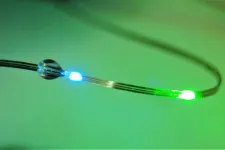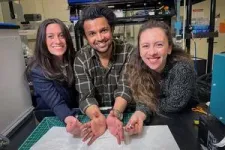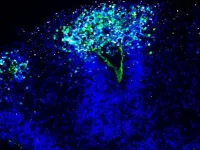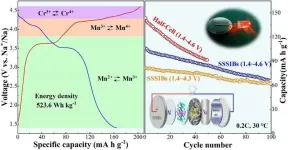(Press-News.org) CAMBRIDGE, MA -- The brain and the digestive tract are in constant communication, relaying signals that help to control feeding and other behaviors. This extensive communication network also influences our mental state and has been implicated in many neurological disorders.
MIT engineers have now designed a new technology that can be used to probe those connections. Using fibers embedded with a variety of sensors, as well as light sources for optogenetic stimulation, the researchers have shown that they can control neural circuits connecting the gut and the brain, in mice.
In a new study, the researchers demonstrated that they could induce feelings of fullness or reward-seeking behavior in mice by manipulating cells of the intestine. In future work, they hope to explore some of the correlations that have been observed between digestive health and neurological conditions such as autism and Parkinson’s disease.
“The exciting thing here is that we now have technology that can drive gut function and behaviors such as feeding. More importantly, we have the ability to start accessing the crosstalk between the gut and the brain with the millisecond precision of optogenetics, and we can do it in behaving animals,” says Polina Anikeeva, the Matoula S. Salapatas Professor in Materials Science and Engineering, a professor of brain and cognitive sciences, associate director of MIT’s Research Laboratory of Electronics, and a member of MIT’s McGovern Institute for Brain Research.
Anikeeva is the senior author of the new study, which appears today in Nature Biotechnology. The paper’s lead authors are MIT graduate student Atharva Sahasrabudhe, Duke University postdoc Laura Rupprecht, MIT postdoc Sirma Orguc, and former MIT postdoc Tural Khudiyev.
The brain-body connection
Last year, the McGovern Institute launched the K. Lisa Yang Brain-Body Center to study the interplay between the brain and other organs of the body. Research at the center focuses on illuminating how these interactions help to shape behavior and overall health, with a goal of developing future therapies for a variety of diseases.
“There’s continuous, bidirectional crosstalk between the body and the brain,” Anikeeva says. “For a long time, we thought that the brain is a tyrant that sends output into the organs and controls everything. But now we know that there’s a lot of feedback back into the brain, and this feedback potentially controls some of the functions that we have previously attributed exclusively to the central neural control.”
Anikeeva, who directs the new center, was interested in probing the signals that pass between the brain and the nervous system of the gut, also called the enteric nervous system. Sensory cells in the gut influence hunger and satiety via both the neuronal communication and hormone release.
Untangling those hormonal and neural effects has been difficult because there hasn’t been a good way to rapidly measure the neuronal signals, which occur within milliseconds.
“To be able to perform gut optogenetics and then measure the effects on brain function and behavior, which requires millisecond precision, we needed a device that didn’t exist. So, we decided to make it,” says Sahasrabudhe, who led the development of the gut and brain probes.
The electronic interface that the researchers designed consists of flexible fibers that can carry out a variety of functions and can be inserted into the organs of interest. To create the fibers, Sahasrabudhe used a technique called thermal drawing, which allowed him to create polymer filaments, about as thin as a human hair, that can be embedded with electrodes and temperature sensors.
The filaments also carry microscale light-emitting devices that can be used to optogenetically stimulate cells, and microfluidic channels that can be used to deliver drugs.
The mechanical properties of the fibers can be tailored for use in different parts of the body. For the brain, the researchers created stiffer fibers that could be threaded deep into the brain. For digestive organs such as the intestine, they designed more delicate rubbery fibers that do not damage the lining of the organs but are still sturdy enough to withstand the harsh environment of the digestive tract.
“To study the interaction between the brain and the body, it is necessary to develop technologies that can interface with organs of interest as well as the brain at the same time, while recording physiological signals with high signal-to-noise ratio,” Sahasrabudhe says. “We also need to be able to selectively stimulate different cell types in both organs in mice so that we can test their behaviors and perform causal analyses of these circuits.”
The fibers are also designed so that they can be controlled wirelessly, using an external control circuit that can be temporarily affixed to the animal during an experiment. This wireless control circuit was developed by Orguc, a Schmidt Science Fellow, and Harrison Allen ’20, MEng ’22, who were co-advised between the Anikeeva lab and the lab of Anantha Chandrakasan, dean of MIT’s School of Engineering and the Vannevar Bush Professor of Electrical Engineering and Computer Science.
Driving behavior
Using this interface, the researchers performed a series of experiments to show that they could influence behavior through manipulation of the gut as well as the brain.
First, they used the fibers to deliver optogenetic stimulation to a part of the brain called the ventral tegmental area (VTA), which releases dopamine. They placed mice in a cage with three chambers, and when the mice entered one particular chamber, the researchers activated the dopamine neurons. The resulting dopamine burst made the mice more likely to return to that chamber in search of the dopamine reward.
Then, the researchers tried to see if they could also induce that reward-seeking behavior by influencing the gut. To do that, they used fibers in the gut to release sucrose, which also activated dopamine release in the brain and prompted the animals to seek out the chamber they were in when sucrose was delivered.
Next, working with colleagues from Duke University, the researchers found they could induce the same reward-seeking behavior by skipping the sucrose and optogenetically stimulating nerve endings in the gut that provide input to the vagus nerve, which controls digestion and other bodily functions.
“Again, we got this place preference behavior that people have previously seen with stimulation in the brain, but now we are not touching the brain. We are just stimulating the gut, and we are observing control of central function from the periphery,” Anikeeva says.
Sahasrabudhe worked closely with Rupprecht, a postdoc in Professor Diego Bohorquez’ group at Duke, to test the fibers’ ability to control feeding behaviors. They found that the devices could optogenetically stimulate cells that produce cholecystokinin, a hormone that promotes satiety. When this hormone release was activated, the animals’ appetites were suppressed, even though they had been fasting for several hours. The researchers also demonstrated a similar effect when they stimulated cells that produce a peptide called PYY, which normally curbs appetite after very rich foods are consumed.
The researchers now plan to use this interface to study neurological conditions that are believed to have a gut-brain connection. For instance, studies have shown that children with autism are far more likely than their peers to be diagnosed with GI dysfunction, while anxiety and irritable bowel syndrome share genetic risks.
“We can now begin asking, are those coincidences, or is there a connection between the gut and the brain? And maybe there is an opportunity for us to tap into those gut-brain circuits to begin managing some of those conditions by manipulating the peripheral circuits in a way that does not directly ‘touch’ the brain and is less invasive,” Anikeeva says.
###
The research was funded, in part, by the Hock E. Tan and K. Lisa Yang Center for Autism Research and the K. Lisa Yang Brain-Body Center at the McGovern Institute, the National Institute of Neurological Disorders and Stroke, the National Science Foundation (NSF) Center for Materials Science and Engineering, the NSF Center for Neurotechnology, the National Center for Complementary and Integrative Health, a National Institutes of Health Director’s Pioneer Award, the National Institute of Mental Health, and the National Institute of Diabetes and Digestive and Kidney Diseases.
END
Unraveling the connections between the brain and gut
MIT engineers’ new technology can probe the neural circuits that influence hunger, mood, and a variety of diseases
2023-06-22
ELSE PRESS RELEASES FROM THIS DATE:
Parental cancer history and children’s unmet food, housing, and transportation economic needs
2023-06-22
About The Study: Parental cancer is associated with greater likelihood of food insecurity, unaffordability of housing and other necessities, and transportation barriers to medical care for minor children. Strategies to identify such children and address their needs are warranted.
Authors: Zhiyuan Zheng, Ph.D., of the American Cancer Society in Atlanta, is the corresponding author.
To access the embargoed study: Visit our For The Media website at this link https://media.jamanetwork.com/
(doi:10.1001/jamanetworkopen.2023.19359)
Editor’s Note: Please ...
Risk of cardiovascular events among patients with head and neck cancer
2023-06-22
About The Study: The results of this study suggest that in head and neck squamous cell carcinoma (HNSCC), the burden of suboptimally controlled cardiovascular (CV) risk factors and incident risk of stroke and heart attack are substantial. Modifiable CV risk factors are associated with risk of adverse CV events, and these events are associated with a higher risk of death. These findings identify populations at risk and potentially underscore the importance of modifiable CV risk factor control and motivate strategies to reduce CV risk in HNSCC survivorship care.
Authors: Lova Sun, M.D., ...
Physicists discover a new switch for superconductivity
2023-06-22
Under certain conditions — usually exceedingly cold ones — some materials shift their structure to unlock new, superconducting behavior. This structural shift is known as a “nematic transition,” and physicists suspect that it offers a new way to drive materials into a superconducting state where electrons can flow entirely friction-free.
But what exactly drives this transition in the first place? The answer could help scientists improve existing superconductors and discover new ones.
Now, MIT physicists have identified the key to how one class of superconductors undergoes a nematic transition, and it’s in surprising contrast to what ...
Studying herpes encephalitis with mini-brains
2023-06-22
The herpes simplex virus-1 can sometimes cause a dangerous brain infection. Combining an anti-inflammatory and an antiviral could help in these cases, report scientists with the Rajewsky and Landthaler labs and the Organoid Platform at the Max Delbrück Center in Nature Microbiology.
About 3.7 billion people — 67% of us — carry the herpes simplex virus-1 in our nerves cells where it lies quiescent until triggered by stress or injury. When activated, its symptoms are usually mild, limited to cold sores or ulcers in our mouth.
Very rarely, the virus ...
New study shows children of parents with cancer history in US may be vulnerable to housing, food and financial hardship
2023-06-22
ATLANTA, June 22, 2023 – A new study by researchers at the American Cancer Society (ACS) found children of parents with a cancer history in the United States are more at risk of having unmet needs for housing, food, and other living necessities than their counterparts without a parental cancer history. The findings will be published today in the Journal of the American Medical Association (JAMA) Network Open.
“Cancer is a life-threatening disease and parents with a history of cancer are often saddled with worry about paying for food, the ...
Never-before-seen way to annihilate a star
2023-06-22
Most stars in the Universe die in predictable ways, depending on their mass. Relatively low-mass stars like our Sun slough off their outer layers in old age and eventually fade to become white dwarf stars. More massive stars burn brighter and die sooner in cataclysmic supernova explosions, creating ultradense objects like neutron stars and black holes. If two such stellar remnants form a binary system, they also can eventually collide. New research, however, points to a long-hypothesized, but never-before-seen, fourth option.
While searching for ...
Stellar demolition derby births powerful gamma-ray burst
2023-06-22
While searching for the origins of a powerful gamma-ray burst (GRB), an international team of astrophysicists may have stumbled upon a new way to destroy a star.
Although most GRBs originate from exploding massive stars or neutron-star mergers, the researchers concluded that GRB 191019A instead came from the collision of stars or stellar remnants in the jam-packed environment surrounding a supermassive black hole at the core of an ancient galaxy. The demolition derby-like environment points to a ...
Einstein and Euler put to the test at the edge of the Universe
2023-06-22
The cosmos is a unique laboratory for testing the laws of physics, in particular those of Euler and Einstein. Euler described the movements of celestial objects, while Einstein described the way in which celestial objects distort the Universe. Since the discovery of dark matter and the acceleration of the Universe’s expansion, the validity of their equations has been put to the test: are they capable of explaining these mysterious phenomena? A team from the University of Geneva (UNIGE) has developed the first method to find out. It ...
Promoting high energy Na4MnCr(PO4)3 capable of three-electron reaction for SSSMBs
2023-06-22
They published their work on June. 9 in Energy Material Advances.
"The development of high safety and high energy density SIBs is imperative," said paper author Zhongyue Wang, lecture with the College of electronic and optical engineering & college of flexible electronics (future technology), Nanjing University of Posts and Telecommunications. "Currently, great progress has been made in sodium-ion batteries, but their energy density is still much lower than LIBs limited by the cathode."
Wang explained that NASICON-type phosphate (NaxMM’(PO4)3, M, M' =transition metal Ti, V, Cr, Mn, Fe, Co and Ni) is regarded ...
Statewide study explores how pre-existing disease has influenced the COVID-19 experience
2023-06-22
INDIANAPOLIS - A study of more than three-quarters of a million Indiana COVID-19 cases is one of the first to focus on the disease in the Midwest. The research examines the relationship between the presence of pre-existing disease and COVID-19 outcomes in a region that has some of the highest prevalence of comorbidities, including hypertension, chronic obstructive pulmonary disease (COPD) and diabetes.
The study, conducted by researchers from Regenstrief Institute, Indiana University and The Ohio State University sourced data through the COVID-19 Research Data Commons. For COVID-19 patients, research demonstrated the pre-existing ...
LAST 30 PRESS RELEASES:
Mount Sinai Health system receives $8.5 million NIH grant renewal to advance research on long-term outcomes in children with congenital heart disease
Researchers develop treatment for advanced prostate cancer that could eliminate severe side effects
Keck Medicine of USC names Christian Pass chief financial officer
Inflatable fabric robotic arm picks apples
MD Anderson and SOPHiA GENETICS announce strategic collaboration to accelerate AI-driven precision oncology
Oil residues can travel over 5,000 miles on ocean debris, study finds
Korea University researchers discover that cholesterol-lowering drug can overcome chemotherapy resistance in triple-negative breast cancer
Ushikuvirus: A newly discovered giant virus may offer clues to the origin of life
Boosting the cell’s own cleanup
Movement matters: Light activity led to better survival in diabetes, heart, kidney disease
Method developed to identify best treatment combinations for glioblastoma based on unique cellular targets
Self-guided behavioral app helps children with epilepsy sleep earlier
Higher consumption of food preservatives is associated with an increased risk of type 2 diabetes
NTU Singapore-led team captures first-ever ‘twitch’ of the eye’s night-vision cells as they detect light, paving the way for earlier detection of blindness-causing diseases
Global aviation emissions could be halved through maximising efficiency gains, new study shows
Fewer layovers, better-connected airports, more firm growth
Exposure to natural light improves metabolic health
As we age, immune cells protect the spinal cord
New expert guidance urges caution before surgery for patients with treatment-resistant constipation
Solar hydrogen can now be produced efficiently without the scarce metal platinum
Sleeping in on weekends may help boost teens’ mental health
Study: Teens use cellphones for an hour a day at school
After more than two years of war, Palestinian children are hungry, denied education and “like the living dead”
The untold story of life with Prader-Willi syndrome - according to the siblings who live it
How the parasite that ‘gave up sex’ found more hosts – and why its victory won’t last
When is it time to jump? The boiling frog problem of AI use in physics education
Twitter data reveals partisan divide in understanding why pollen season's getting worse
AI is quick but risky for updating old software
Revolutionizing biosecurity: new multi-omics framework to transform invasive species management
From ancient herb to modern medicine: new review unveils the multi-targeted healing potential of Borago officinalis
[Press-News.org] Unraveling the connections between the brain and gutMIT engineers’ new technology can probe the neural circuits that influence hunger, mood, and a variety of diseases






